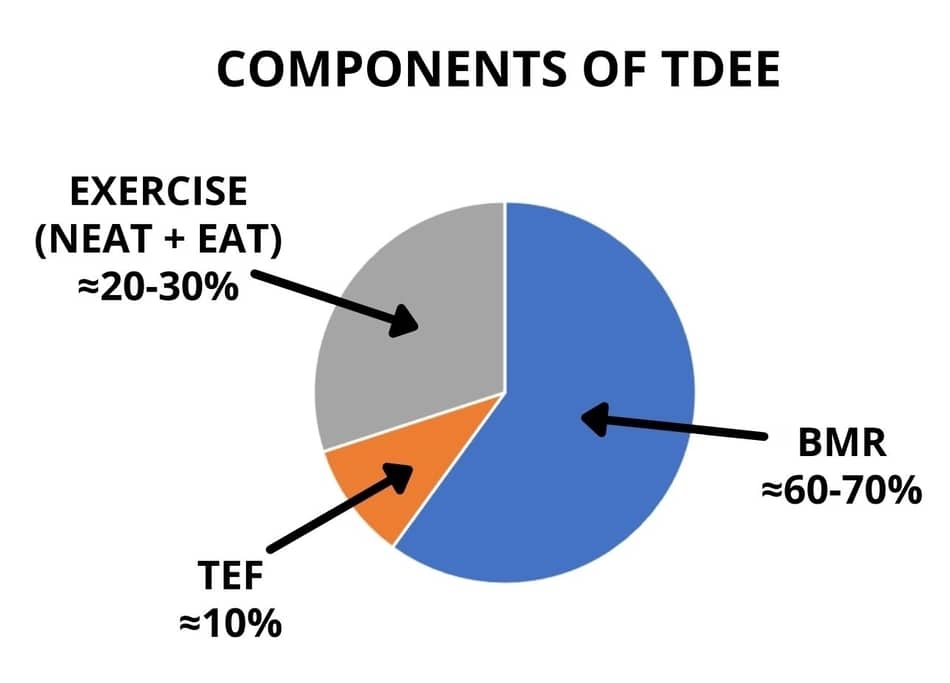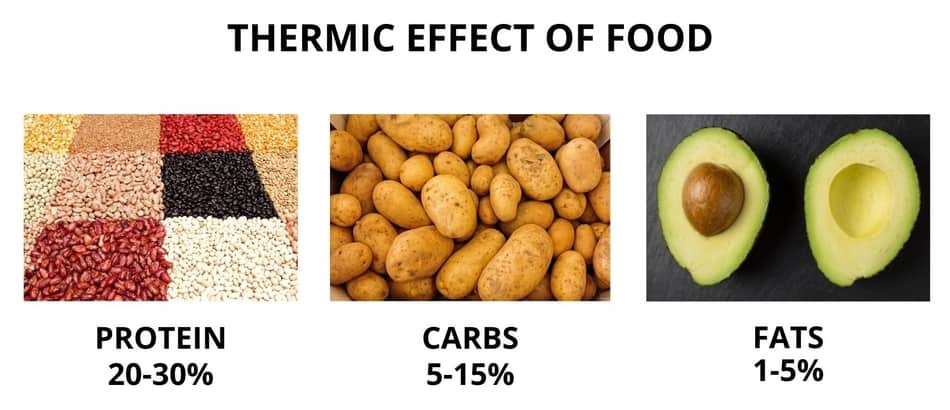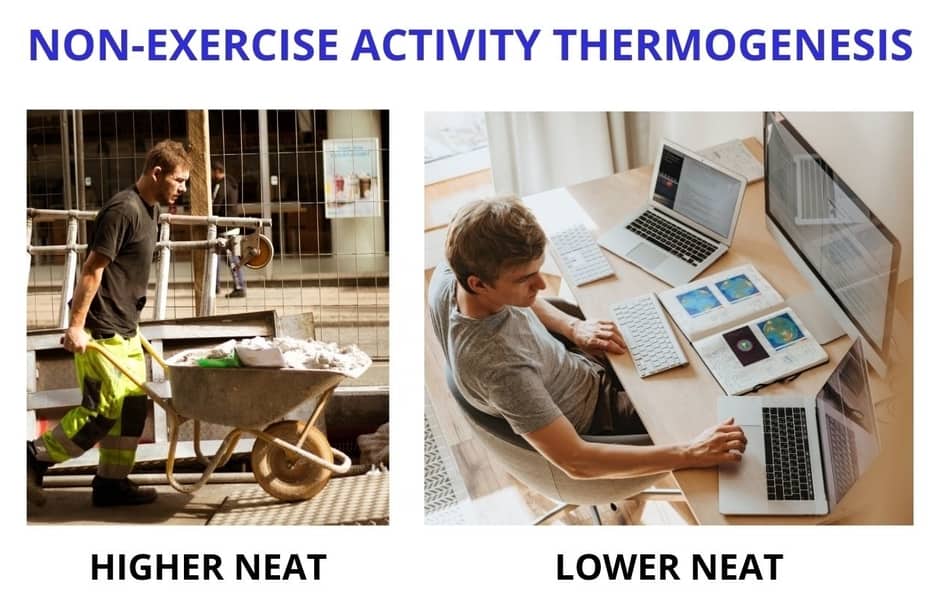
Regardless of whether your goal is to lose or to gain weight, it is helpful to understand the ways in which your body burns calories.
In either case, what matters most is comparing the daily calories you eat (energy intake) with the daily calories you burn (energy expenditure).
If you consume fewer calories (energy intake) than you burn (energy expenditure), you will lose weight because your body uses all of the energy from the food you eat, and you will then need to burn body fat for energy.
If you consume more calories than you burn, you will gain weight because your body will have an excess of energy supply (calories) that will be stored as fat.
This is why understanding how your body actually burns calories is important. The number of calories you burn will indicate how much you should be eating each day.
Components of Total Daily Energy Expenditure (TDEE)
TDEE or Total Daily Energy Expenditure represents the total number of calories you burn each day. It consists of the following four categories:
- Basal metabolic rate
- Thermic effect of food
- Non-exercise activity thermogenesis (NEAT)
- Exercise activity thermogenesis (EAT)

Each one of these four categories (BMR, TEF, NEAT, EAT) makes up a percentage of your total TDEE. Fortunately, we have a certain level of control over all four categories.
Let’s consider each of them in turn.
Basal Metabolic Rate
Basal Metabolic Rate is the number of calories required to keep your body functioning at rest (yes, we do burn calories even when we’re not doing anything).
These basic body functions include circulation, breathing, cell production, etc. All these functions require energy.
Your BMR is impacted by various factors, such as gender, height, weight, age, and body composition. While you cannot control genetic factors, you can control your body composition, which will impact your BMR.
What is the most important thing you can do to affect your BMR? Build muscle!
When your body is at rest, lean muscle mass burns more calories than fat, meaning the more muscle you have, the more calories you will burn, even when your body is at rest.
In fact, each pound of muscle burns roughly 6-7 calories. On the other hand, each pound of fat burns roughly 2 calories. While this may not seem significant, every little difference adds up. So to increase your BMR focus on gaining muscle.
Interestingly, Basal Metabolic Rate accounts for roughly 60-70% of total daily energy expenditure, meaning the majority of the calories you burn each day are actually due to processes that occur when your body is at rest.
But don’t let that discourage you because we have a good deal of control over the following three categories.
Thermic Effect of Food
Again, our bodies get energy from the calories in the foods that we eat. In the process of converting those calories to energy it can use, your body actually needs to use some energy. In other words, the process of digestion itself requires energy (calories).
The thermic effect of food refers to this energy (calories) needed to convert the calories you eat into energy your body can use.
The thermic effect of food is different depending on the type of macronutrients you consume. This is why the foods you eat actually affect how many calories you burn on a daily basis.
- Protein: 20-30%
- Carbs: 5-15%
- Fats: 1-5%

To put these images into words, protein uses 20-30% of the calories you eat in the process of digestion, so you are only left with 70-80% of the calories you ate. For carbohydrates, it is 5-15%, and fats is 1-5%.
While the percentages seem significant, the thermic effect of food on average only accounts for about 10% of total energy expenditure.
Furthermore, it’s easy to look at these statistics and base your diet around them; however, I would not recommend doing that for the following two reasons:
By looking at the statistics in the image above, it would be easy to claim that fats are “fattening” and protein is the king. However, it’s much more complicated than that. For instance, research shows that there is an inverse relationship between consumption of nuts and BMI, meaning the more nuts people tend to eat, the lower their BMI.
The explanation for this is likely that nuts make people feel full and therefore less likely to eat more food. Of course, this doesn’t mean you should eat tons and tons of nuts each day expecting to lose weight. Due to the fact that nuts are high calorie foods, you should eat them in moderation if your goal is weight loss.
The second and arguably most important reason why I would not focus on the thermic effect of food for different macronutrients is that what matters more is eating whole foods.
Research shows that digesting and processing whole foods burn up to 50% more calories than processed foods. Therefore, the thermic effect of food is far more impactful when it comes to processed vs. whole foods compared to the different macronutrients.
For this reason, instead of worrying about the thermic effect of different macronutrients, focus on consuming as many whole foods as possible, especially if your goal is weight loss (and general health).
Non-Activity Exercise Thermogenesis
Non-exercise activity thermogenesis (NEAT) refers to energy expended for everything we do throughout the day that is not sleeping, eating, or structured exercise. This includes activities like walking around, typing, or household chores.
Of course, NEAT varies significantly depending on a person’s lifestyle. Someone who works a desk job and lives a relatively sedentary lifestyle will have a low NEAT. On the other hand, someone who works a job where they’re standing and moving around all day would have a much higher NEAT and would burn more calories throughout the day.

While there is a genetic component to NEAT, people who claim to have “fast metabolisms” are likely living a more active lifestyle, whereas people who claim to have “slow metabolisms” are probably not moving around as much.
For example, when I use to play basketball 5 days per week, I had to eat a lot to simply maintain my weight (“fast metabolism”); on the other hand, when the quarantine hit in 2020, and I was much more sedentary, I needed to reduce the amount I ate to maintain my weight (“slow metabolism”).
Because the activity of each individual will vary greatly, NEAT may account for a very small percentage of TDEE, or for a significant amount.
Exercise Activity Thermogenesis
Exercise Activity Thermogenesis (EAT) refers to energy expended during exercise. If you exercise very little, your EAT will be low, whereas if you exercise more, your EAT will be higher.
As suggested in the example above, if you have ever played a demanding sport where you practice daily, you probably notice yourself being able to eat more while still maintaining the same body weight. On the other hand, when you stop practicing daily, you might notice yourself gaining weight or needing to eat less in order to maintain your current weight. This can be understood as your EAT either increasing or decreasing.
As I already mentioned, unless you are an athlete exercising a lot, exercise typically makes up only around 5-10% of TDEE. This is why I don’t recommend exercise alone for weight loss. You also need to have a healthy diet.
How Do You Calculate Your TDEE?
Now that you know the four factors that determine how many calories your body burns each day, you are probably wondering how to determine the number of calories you personally burn each day (which will dictate how many calories you should eat).
Based on the information in this article you can see that everyone’s caloric intake is going to be different, depending on lifestyle.
While I am not an advocate of strictly eating based on a certainly number of calories you set aside for yourself each day, (I will further explain why in the next article), knowing how many calories you should eat each day can be helpful for some people, especially for those who have never tracked their calories.
For that reason, in part 2 of this article series (click here), I discuss an approach to calculating your own calories that will allow you to determine your maintenance calories (how many calories you burn each day) so that you can structure the way you eat to either lose weight, maintain your weight, or gain weight depending on your goals. Again, that article can be found here.
And as always, if you have any questions, ask them below and I’ll get back to you as soon as I can.

